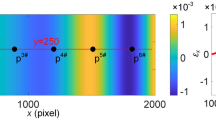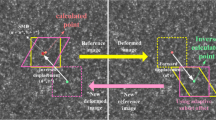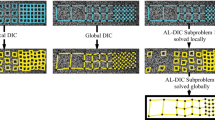Abstract
Background
Digital image correlation (DIC) has advanced to become a flexible, reliable and fast optical method for the measurement of non-contact and full-field surface deformation. However, the accuracy of existing methods in measuring heterogeneous deformation fields—especially for the high gradient strain field – can be improved.
Objective
In state-of-art local DIC applications, several methods have been put forward to adapt a subset to unknown deformation. Although improvements in performance using these methods are obtained, results are still ungratified for severely heterogeneous deformation such as the Star 2 and Star 5 images from DIC Challenge 2.0.
Methods
In this paper, a rotated Gaussian weighted zero-mean normalized sum of squared difference (RGW-ZNSSD) criterion function is proposed as the basis for RGW-DIC subset size adaptation. RGW-DIC can automatically determine the optimum weight distribution, hence self-adaptivity in subset size and orientation are achieved simultaneously.
Results
The effectiveness of the proposed RGW-DIC is verified using DIC-challenge 2.0 images and simulated sinusoidal deformation images. Results reveal that the adaptively determined subset weight distribution can significantly improve the accuracy of heterogeneous deformation measurement compared with traditional DIC and DIC with isotropic Gaussian weight functions.
Conclusions
The proposed RGW-DIC can be applied to unknown severely heterogeneous deformation measurement.














Similar content being viewed by others
References
Pan B, Xie H, Guo Z, Hua T (2007) Full-field strain measurement using a two-dimensional Savitzky-Golay digital differentiator in digital image correlation. Opt Eng 46. https://doi.org/10.1117/1.2714926
Zhao J, Song Y, Wu X (2015) Fast Hermite element method for smoothing and differentiating noisy displacement field in digital image correlation. Opt Lasers Eng 68:25–34. https://doi.org/10.1016/j.optlaseng.2014.12.010
Zhao J, Zeng P, Pan B et al (2012) Improved Hermite finite element smoothing method for full-field strain measurement over arbitrary region of interest in digital image correlation. Opt Lasers Eng 50:1662–1671. https://doi.org/10.1016/j.optlaseng.2012.04.008
Li X, Fang G, Zhao J et al (2019) Local Hermite (LH) Method: An accurate and robust smooth technique for high-gradient strain reconstruction in digital image correlation. Opt Lasers Eng 112:26–38. https://doi.org/10.1016/j.optlaseng.2018.08.022
Li X, Fang G, Zhao J et al (2019) A practical and effective regularized polynomial smoothing (RPS) method for high-gradient strain field measurement in digital image correlation. Opt Lasers Eng 121:215–226. https://doi.org/10.1016/j.optlaseng.2019.04.017
Pan B, Xie H, Wang Z (2010) Equivalence of digital image correlation criteria for pattern matching. Appl Opt 49:5501–5509. https://doi.org/10.1364/AO.49.005501
Schreier H, Orteu JJ, Sutton MA (2009) Image correlation for shape, motion and deformation measurements: Basic concepts, theory and applications. Springer, US
Tu P, Liu X (2017) An Error Criterion in Digital Image Correlation for Unknown Deformation Fields and Its Application of Parameters Selection. Exp Mech 57:783–799. https://doi.org/10.1007/s11340-017-0268-0
Tong W (2005) An evaluation of digital image correlation criteria for strain mapping applications. Strain 41:167–175. https://doi.org/10.1111/j.1475-1305.2005.00227.x
Pan B, Xie H, Wang Z et al (2008) Study on subset size selection in digital image correlation for speckle patterns. Opt Express 16:7037. https://doi.org/10.1364/oe.16.007037
Liu J, Iskander M (2004) Adaptive cross correlation for imaging displacements in soils. J Comput Civ Eng 18:46–57. https://doi.org/10.1061/(ASCE)0887-3801(2004)18:1(46)
Wang ZY, Li HQ, Tong JW, Ruan JT (2007) Statistical analysis of the effect of intensity pattern noise on the displacement measurement precision of digital image correlation using self-correlated images. Exp Mech 47:701–707. https://doi.org/10.1007/s11340-006-9005-9
Pan B, Li K, Tong W (2013) Fast, Robust and Accurate Digital Image Correlation Calculation Without Redundant Computations. Exp Mech 53:1277–1289. https://doi.org/10.1007/s11340-013-9717-6
Schreier HW, Sutton MA (2002) Systematic errors in digital image correlation due to undermatched subset shape functions. Exp Mech 42:303–310. https://doi.org/10.1177/001448502321548391
Yu L, Pan B (2015) The errors in digital image correlation due to overmatched shape functions. Meas Sci Technol 26. https://doi.org/10.1088/0957-0233/26/4/045202
Huizinga W, Klein S, Poot DHJ (2014) Fast multidimensional B-spline interpolation using template metaprogramming. Lect Notes Comput Sci (including Subser Lect Notes Artif Intell Lect Notes Bioinformatics) 8545 LNCS:11–20. https://doi.org/10.1007/978-3-319-08554-8_2
Su Y, Zhang Q, Gao Z et al (2015) Fourier-based interpolation bias prediction in digital image correlation. Opt Express 23:19242. https://doi.org/10.1364/oe.23.019242
Wang YQ, Sutton MA, Bruck HA, Schreier HW (2009) Quantitative error assessment in pattern matching: Effects of intensity pattern noise, interpolation, strain and image contrast on motion measurements. Strain 45:160–178. https://doi.org/10.1111/j.1475-1305.2008.00592.x
Rossi M, Lava P, Pierron F et al (2015) Effect of DIC spatial resolution, noise and interpolation error on identification results with the VFM. Strain 51:206–222. https://doi.org/10.1111/str.12134
Zitová B, Flusser J (2003) Image registration methods: A survey. Image Vis Comput 21:977–1000. https://doi.org/10.1016/S0262-8856(03)00137-9
Kehoe L, Lynch P, Guénebaut V (2006) Measurement of deformation and strain in first level C4 interconnect and stacked die using optical digital image correlation. IMAPS Int Conf Exhib Device Packag - Co-located with Glob Bus Counc GBC 2006 Spring Conf 1874–1881
Ke XD, Schreier HW, Sutton MA, Wang YQ (2011) Error Assessment in Stereo-based Deformation Measurements. Exp Mech 51:423–441. https://doi.org/10.1007/s11340-010-9450-3
Yaofeng S, Pang JHL (2007) Study of optimal subset size in digital image correlation of speckle pattern images. Opt Lasers Eng 45:967–974. https://doi.org/10.1016/j.optlaseng.2007.01.012
Zhao J (2016) Deformation measurement using digital image correlation by adaptively adjusting the parameters. Opt Eng 55:124104. https://doi.org/10.1117/1.oe.55.12.124104
Wang B, Pan B (2019) Self-Adaptive Digital Volume Correlation for Unknown Deformation Fields. Exp Mech 59:149–162. https://doi.org/10.1007/s11340-018-00455-2
Wang B, Pan B (2019) Anisotropic self-adaptive digital volume correlation with optimal cuboid subvolumes. Meas Sci Technol 30. https://doi.org/10.1088/1361-6501/ab2f82
Wittevrongel L, Lava P, Lomov SV, Debruyne D (2015) A Self Adaptive Global Digital Image Correlation Algorithm. Exp Mech 55:361–378. https://doi.org/10.1007/s11340-014-9946-3
Hoefnagels JPM, Kleinendorst SM, Ruybalid AP et al (2017) Self-adaptive isogeometric global digital image correlation and digital height correlation. Conf Proc Soc Exp Mech Ser 3:165–172. https://doi.org/10.1007/978-3-319-41600-7_20
Hild F, Roux S (2012) Comparison of Local and Global Approaches to Digital Image Correlation. Exp Mech 52:1503–1519. https://doi.org/10.1007/s11340-012-9603-7
Yang J, Bhattacharya K (2018) Fast Adaptive Global Digital Image Correlation
Huang J, Pan X, Peng X et al (2013) Digital Image Correlation with Self-Adaptive Gaussian Windows. Exp Mech 53:505–512. https://doi.org/10.1007/s11340-012-9639-8
Yuan Y, Huang J, Peng X et al (2014) Accurate displacement measurement via a self-adaptive digital image correlation method based on a weighted ZNSSD criterion. Opt Lasers Eng 52:75–85. https://doi.org/10.1016/j.optlaseng.2013.07.016
Yuan Y, Huang J, Fang J et al (2015) A self-adaptive sampling digital image correlation algorithm for accurate displacement measurement. Opt Lasers Eng 65:57–63. https://doi.org/10.1016/j.optlaseng.2014.05.006
Reu PL (2018) 2D Challenge 2.0 Discussion Document. United States
Pan B, Xie HM, Xu BQ, Dai FL (2006) Performance of sub-pixel registration algorithms in digital image correlation. In: Measurement Science and Technology. Institute of Physics Publishing, pp 1615–1621
Chen W, Jiang Z, Tang L et al (2017) Equal Noise Resistance of Two Mainstream Iterative Sub-pixel Registration Algorithms in Digital Image Correlation. Exp Mech 57:979–996. https://doi.org/10.1007/s11340-017-0294-y
Baker S, Matthews I (2004) Lucas-Kanade 20 Years On : A Unifying Framework : Part 1 2 Background : Lucas-Kanade. Int J Comput Vis 56:221–255. https://doi.org/10.1023/B:VISI.0000011205.11775.fd
Gao Y, Cheng T, Su Y et al (2015) High-efficiency and high-accuracy digital image correlation for three-dimensional measurement. Opt Lasers Eng 65:73–80. https://doi.org/10.1016/j.optlaseng.2014.05.013
Baker S, Matthews I (2004) Lucas-Kanade 20 years on: A unifying framework. Int J Comput Vis 56:221–255. https://doi.org/10.1023/B:VISI.0000011205.11775.fd
Pan B (2009) Reliability-guided digital image correlation for image deformation measurement. Appl Opt 48:1535–1542. https://doi.org/10.1364/AO.48.001535
Xu X, Su Y, Zhang Q (2017) Theoretical estimation of systematic errors in local deformation measurements using digital image correlation. Opt Lasers Eng 88:265–279. https://doi.org/10.1016/j.optlaseng.2016.08.016
Xu X, Su Y, Cai Y et al (2015) Effects of Various Shape Functions and Subset Size in Local Deformation Measurements Using DIC. Exp Mech 55:1575–1590. https://doi.org/10.1007/s11340-015-0054-9
Lu H, Cary PD (2000) Deformation measurements by digital image correlation: Implementation of a second-order displacement gradient. Exp Mech 40:393–400. https://doi.org/10.1007/BF02326485
Wang B, Pan B (2015) Random Errors in Digital Image Correlation Due to Matched or Overmatched Shape Functions. Exp Mech 55:1717–1727. https://doi.org/10.1007/s11340-015-0080-7
Acknowledgements
This work has been supported by the National Natural Science Foundation of China under grant 51705279, Tsinghua University Scientific Research Found and National S&T Major Project (Grant No. ZX069). We thank Benoît Blaysat, PhD (University Clermont Auvergne, France) for providing the spatial resolution calculating code.
Author information
Authors and Affiliations
Corresponding author
Ethics declarations
Conflict of Interests
The authors declare that they have no conflicts of interest.
Additional information
Publisher's Note
Springer Nature remains neutral with regard to jurisdictional claims in published maps and institutional affiliations.
Rights and permissions
About this article
Cite this article
Ye, X., Zhao, J. Adaptive Rotated Gaussian Weighted Digital Image Correlation (RGW-DIC) for Heterogeneous Deformation Measurement. Exp Mech 62, 271–286 (2022). https://doi.org/10.1007/s11340-021-00790-x
Received:
Accepted:
Published:
Issue Date:
DOI: https://doi.org/10.1007/s11340-021-00790-x




